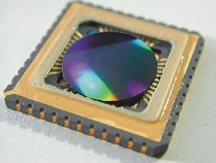Ph.D. thesis
Thesis title: | Lithium intercalation in preferentially oriented submicron LiCoO2 films |
Year: | 2002 |
Promotors: | Prof. Dr. D.N. Reinhoudt Prof. Dr. P.H.L. Notten |
Assistant promotor: | Dr. B.A. Boukamp |
Summary

The basic principle of rechargeable lithium batteries: the “lithium intercalation” of the positive electrode has been studied to determine the key aspects of this process.
The active material is a LiCoO2 ceramic layer. Two different plasma deposition techniques have been applied to grow well-defined LiCoO2 films on silicon and polished stainless steel substrates. These are: Pulsed Laser Deposition (PLD) and RF-sputtering. These films obtain a layered, polycrystalline structure (R-3m) after an annealing treatment (600°C for 30min). The orientation of the two-dimensional host lattice towards the substrate depends on the deposition rate. A (pulsed) high deposition rate leads to a so-called c-axis orientation, as observed here in the case of the PLD-film, while a continuous low deposition rate results in an a-axis oriented film, as observed here for the RF-films.
The lithium content is controlled by electrochemical (de-) intercalation of lithium ions from the electrolyte solution. As only one side of the film is exposed to the electrolyte, the orientation of the film has large consequences for the intercalation rate and capacity: the a-axis oriented films are able to sustain high currents for long periods of time due to the accessibility of the host structure. The c-axis oriented films appear inaccessible and thus exhibit inferior properties. Using polished stainless steel substrates or etching holes in the film after deposition, improves the intercalation properties of the c-axis oriented films.
Finally a ceramic micro-battery has been constructed on the bases of the a-axis oriented LiCoO2 films on silicon substrates. This prototype shows the feasibility of on-chip power (backup) for integrated circuits.
